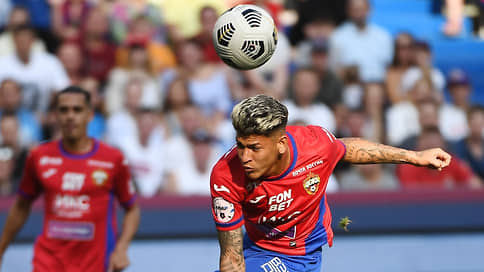Football turned the streams – Newspaper Kommersant No. 166 (7367) of 09/09/2022
[ad_1]

The summer transfer window closed on Thursday in the Russian Premier League (RPL) perfectly illustrated the impact of “isolation” sanctions on the domestic football market. Spending on strengthening the clubs of the Russian Premier League (RPL) has almost halved compared to a year ago, from €125 million to €77 million. In addition, the restrictions have changed the geography of purchases by RPL representatives on the international market. It has become much harder for them to attract players from Western Europe. On the other hand, activity increased in Eastern European and Latin American directions.
On Friday night, the summer transfer window closed in the RPL, the first since Russian sports faced serious restrictions imposed by international sports federations amid a military special operation in Ukraine. With regard to football, they resulted in the removal of all domestic clubs and national teams from playing in international tournaments. There was no doubt that due to the sanctions, which mean the loss of part of the income and the decrease in the interest of foreigners in the Russian championship, the RPL will reduce activity in the transfer market, there was no doubt. The decline turned out to be very serious.
In total, RPL clubs spent just over €77 million on new players. Against the backdrop of giants such as the English Premier League (EPL), whose teams threw insane €2.3 billion on newcomers in the summer, these are crumbs. But this is very little even against the backdrop of investments by the RPL itself in previous seasons. Last summer, even before all the restrictions, Russian clubs spent €125 million on strengthening, in the summer of 2020 – €124 million, in 2019 – €247 million.
The fall is large, however, oddly enough, in the recent history of the RPL there were periods even “quieter”. In 2018, the teams’ spending on strengthening amounted to just over €67 million, and in 2015 it sank altogether to €19 million.
CSKA showed the most activity this summerwho signed players for € 12 million. Half of this amount went to buy Colombian midfielder Jorge Carrascal from the Argentine River Plate, rented back in the winter, Chilean midfielder Victor Mendez cost € 2.5 million, another € 2 million was given for Brazilian defender William Rosho . The second in terms of expenses with an indicator of almost € 10 million was Lokomotiv, among whose acquisitions two defenders stand out – Brazilian Lucas Fasson and Albanian Mario Mitai: both cost €3 million each. In general, the railway workers did not go beyond the amount of €12 million received from the sale of French midfielder Alexis Beck-Beck to Nice. By the way, this is the largest RPL transfer in the summer transfer window. Three closed “Spartak”, marked by the most expensive deal to acquire a player in the league. Again, we are talking about buying out Luxembourger Christopher Martins from the Swiss Young Boys for €6.4 million after a loan. In total, the red-whites allocated €9.6 million for strengthening. Zenit spent the summer calmly, having invested money – € 8 million – only in Colombian forward Mateo Cassierra and Brazilian defender Rodrigueu who moved to St. Petersburg. You can understand the unwillingness of Petersburgers to spend a lot. By Russian standards, they already have the strongest squad, and the prospects for returning to European competition are still very vague.
In addition to the decrease in the financial activity of the RPL clubs, it is worth paying attention to the change, largely forced, of the geographical preferences of the clubs. In recent years, Russian teams have been quite active in buying Western European players (see table). Say, in 2018, they accounted for about a third of all purchases. The second most popular among RPL clubs have traditionally been players from Eastern Europe. For example, in 2020 their share in summer transfers exceeded 45%. But in the current conditions, it is much more difficult for clubs to attract Europeans. Many of them left Russia during the last season.
According to the results of the summer campaign in 2022, the transfers to RPL clubs of Western European players can be counted in the most literal sense of the word using the fingers of one hand.
The decrease in the number of players from Western Europe also affected the total number of foreigners bought by Russian clubs in the summer (we are talking about transfers from foreign clubs). In total, there were 42 such transfers – the worst figure in the last five years. Rescued in this situation, as always, the bottomless football markets of South America and more active recruitment in Eastern Europe. A dozen players moved from South American countries to the RPL, which is the best indicator for this direction in a five-year period. As for representatives of Eastern Europe, they arrived more than representatives of any other region – 14. This is a third of all foreigners bought in the summer, although not a record: there were years when clubs from Eastern Europe recruited 40% or more foreigners.
Geographical preferences of RPL clubs in the summer transfer market
Year Total purchased legionnaires Zap. Europe East Europe Lat. America Africa Asia
2022 42 4 (9.5) 14 (33.3) 12 (28.5) 9 (21.4) 3 (7.1)
2021 49 17 (34.6) 11 (22.4) 10 (20.7) 9 (18.3) 2 (4)
2020 62 7 (11.2) 28 (45.1) 9 (14.5) 10 (16.1) 8 (12.9)
2019 59 17 (28) 23 (40) 9 (15) 10 (17) 0
2018 49 17 (34.6) 18 (36.7) 6 (12.2) 7 (14.2) 1 (2)
In parentheses, the share as a percentage of the total number of new legionnaires.
[ad_2]
Source link









